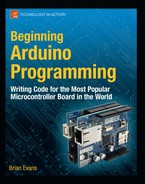What is Sketching in Code?
The idea of sketching in code is a way of thinking about writing code as a simple intuitive process, just like drawing in a sketchbook. In this way, an Arduino program is called a sketch and is saved in a folder called a sketchbook. Sketching means we can get our hands dirty and quickly try out a new idea. It is a skill available to all of us, not just artists and designers, and neither is it limited to pens, paper, pencils, or napkins.
So often, an idea in one of my classes begins with the simple words, “Wouldn’t it be cool if …?” Quickly sketching out these ideas serves as a way to conceptualize this moment of inspiration. Writing code can be just like this; it is after all a creative process used to solve specific problems. Sketching implies a sense of directness in the application of materials, like a pencil to a piece of paper. The Arduino development environment takes this same approach to making code as simple and direct as is possible. It is also why we will begin with simple sketches that quickly get you making something right away rather than bogging down in page after page of complex theory or algorithms.
When sketching in code, it’s okay to write bad code. You won’t hurt anything. As long as you get in there and start somewhere, as doing anything is always better than doing nothing. Making mistakes and learning what does work and what doesn’t, is an important part of learning anything new. In our sketchbook, we will start with simple source code, the basic instructions that tell the Arduino what it should do, along with basic hardware, starting small and working our way through to more involved examples.
You should freely experiment with every example, changing values, and piecing things together in unexpected ways to see what happens. Don’t be discouraged if it doesn’t work the first time; stick with it and it will get clearer with time. Testing and iterations are important parts of successfully writing code. So, change existing code or write some new code to establish a basic framework and then verify that your changes compile correctly. Work in incremental steps one addition at a time as you add to this basic framework for your code so that when you finally have something substantial, you can load it on to the interface board to see what happens. If something didn’t quite work as expected, all you need to do is undo that last incremental step. In this way it’s a good idea when you make changes, to only change one thing at a time before verifying that it still works before moving on to the next change.
